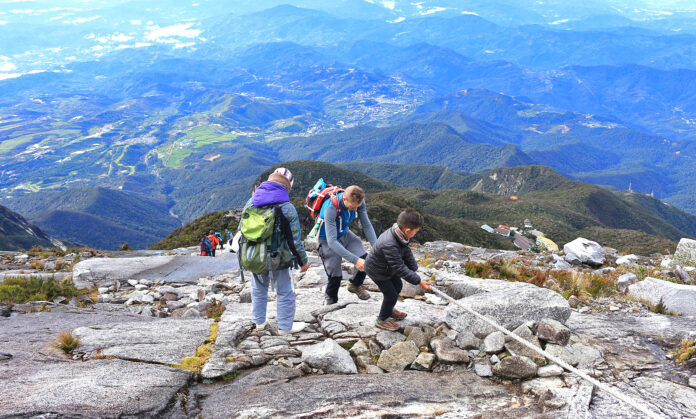A very valid question to ask when you’re thinking of climbing Mount Kinabalu is “How hard is Mount Kinabalu to climb?”
As someone who has climbed Mount Kinabalu twice now, I would rate the Mount Kinabalu climb difficulty as ‘DIFFICULT’ (based on a rating of Easy, Moderate, Difficult or Extremely Difficult).
Of course, this difficulty level depends on your physical fitness. So, someone who is extremely fit and an experienced climber will probably find this climb less difficult than someone who is a beginner.
So, let’s take a look at why the Mount Kinabalu climb is rated as ‘difficult’.
“The mount kinabalu climb is rated as ‘difficult’ for many reasons.”
Why is the Mount Kinabalu Climb Difficult?
There are a lot of factors that affect a climb up a mountain. These range from distance, elevation gain, altitude, track conditions, weather conditions, physical fitness levels, temperature and humidity, as well as clothing and gear.
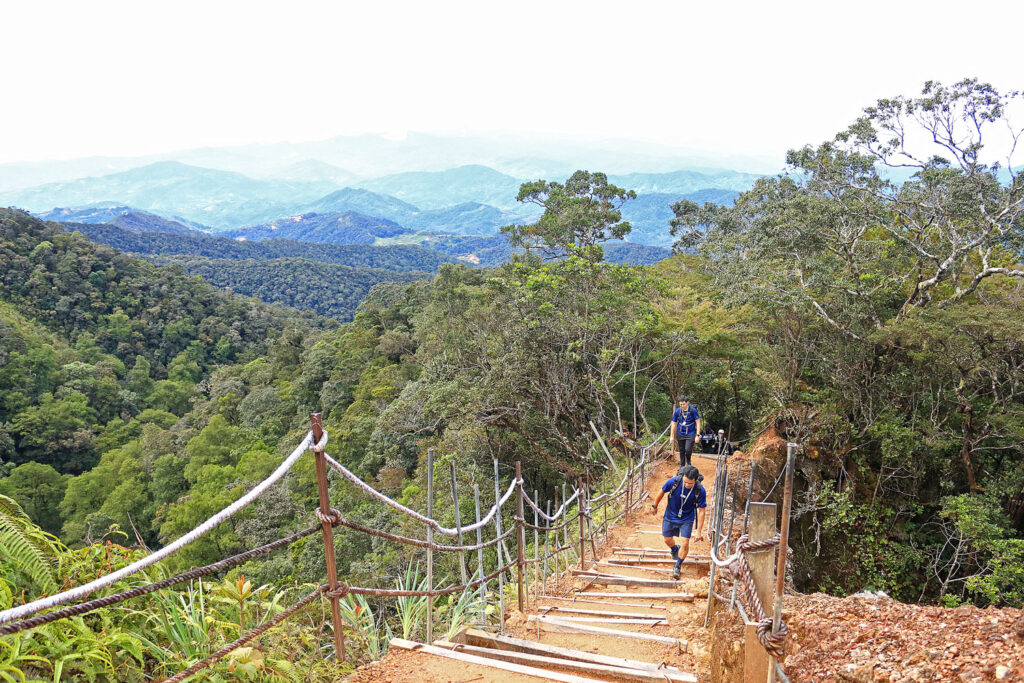
1. Distance
It is an 8.5 kilometer (5.25 miles) trek to the top of Mount Kinabalu. So, the total distance to climb and descend Mount Kinabalu is 17 kilometers (10.5 miles) all up. For most people, this distance is not too much given that you will be completing it over two days.
Two things to bear in mind when considering this distance.
Firstly, the difficulty with the Day 1 climb is the constant uphill climb.
Secondly, most of the distance will be covered on Day 2.
On Day 1, you will climb 5.8 kilometers (3.6 miles) to Laban Rata guesthouse.
On Day 2, you will climb from Laban Rata to the summit of Mount Kinabalu which is 2.7 kilometers (1.68 miles). Then, you will descend to the bottom of the mountain. So, the total distance covered on Day 2 is 11.2 kilometers (6.96 miles).
In my opinion, Day 2 is a lot harder than Day 1. In addition to the extra mileage you will need to cover on Day 2, you will also be tired from trekking on Day 1. Plus, you will have to start Day 2 at 2am in the morning which makes it a very long day of hiking. For most people, the climb downhill is a lot harder on the legs, especially their knees.
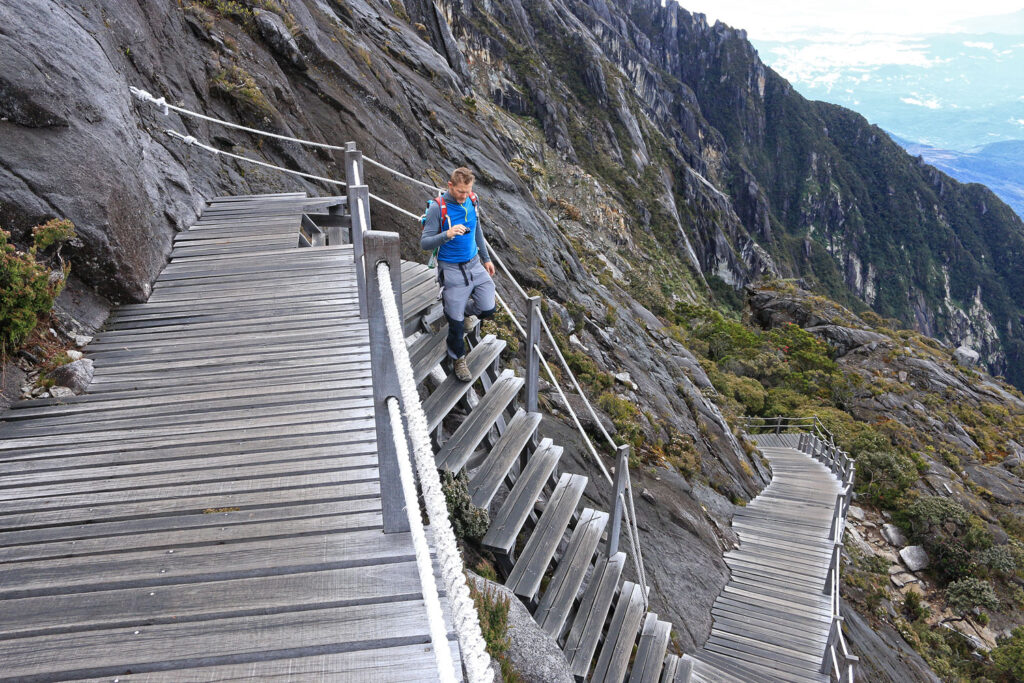
2. Elevation Gain
The summit of Mount Kinabalu sits at 4,095 meters (13,435 feet). From the base starting at Timpohon Gate (1,866 meters or 6,122 feet), the total elevation gain is 2,229 meters (7,313 feet). Of this, you will be climbing 1,406 meters (4,613 feet) on Day 1 to get to Laban Rata (3,272 meters or 10,735 feet). The remaining 823 meters (2,700 feet) you will climb on the morning of Day 2.
As I said earlier, Day 2 is a lot harder than Day 1. In spite of the uphill climb on Day 1, Day 2 is a lot harder as you have to climb to the summit in the dark in the middle of the night. And then follow it up with a descent to the bottom. This means you will be descending 2,229 meters (7,313 feet) continuously on a very steep path which will really put your legs to the test.
“DAY 2 is the harder of the two-day climb.”
My Experience
When we were climbing on Day 1, we saw a few people who were descending sitting on the side of the path. Some were getting leg massages, with what smelled like Tiger balm, to ease the pain from their muscles.
At the end of Day 2, my legs were starting to cramp as well. One of the reasons for this was I wasn’t using trekking poles. As someone who has had children, my knees are a lot weaker these days and not as strong as they used to be. I had to stop at each hut along the way down to rest my weary legs and stretch them out.
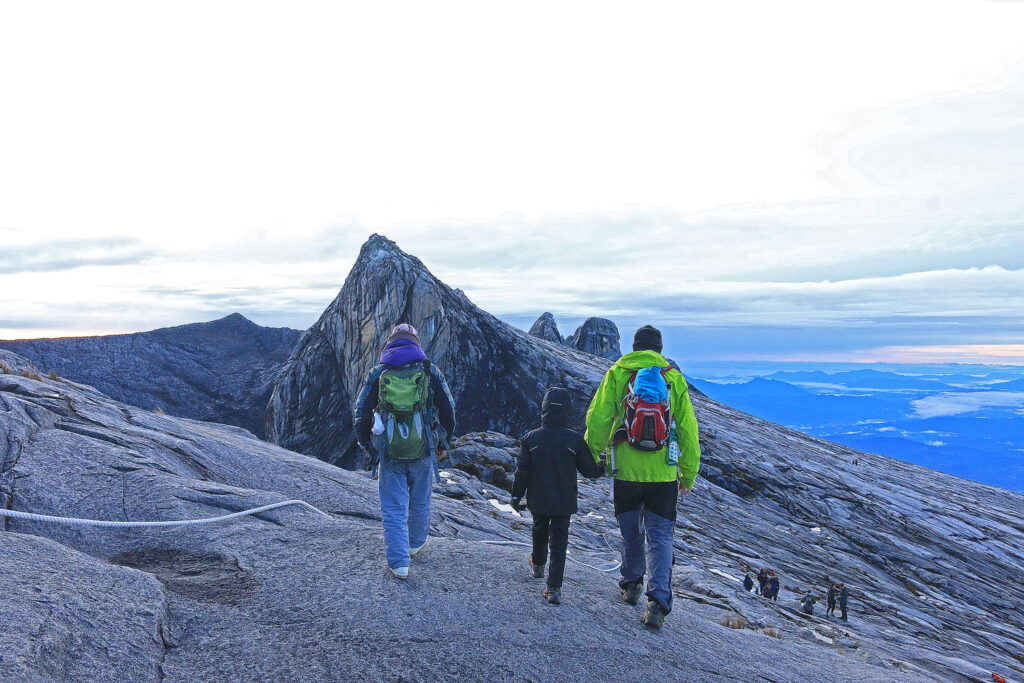
3. Altitude
The summit of Mount Kinabalu sits at 4,095 meters (13,435 feet). Most people live at sea level or near sea level. So their bodies are not used to being at elevation.
In my opinion, the body starts to experience altitude shocks from 3,500 meters (11,483 feet) onwards. This is especially true if the body hasn’t been at that altitude before. That’s because the body hasn’t learnt to deal with those conditions yet. The more practice it gets, the better it will cope with being at altitude.
So, if this is the first time for you at altitude, expect your body to react to the high altitude when you’re climbing to the summit in the wee hours of Day 2.
“mount kinabalu sits at a height of 4,095 metres or 13,435 feet.”
My Experience
The first time I climbed Mount Kinabalu, I had never been at that altitude before. So, I started to feel the effects of altitude while climbing to the summit in the early hours of the morning. I could only take a couple of steps before I had to stop to catch my breath. It was slow moving, one step in front of the other. The last couple hundred meters was the hardest for me. But I walked slowly and steadily and took my time. And got to the summit in time to see the beautiful sunrise above the clouds.
The second time I climbed I had a totally different experience. Since I had climbed Everest Base Camp (5,364 meters or 17,598 feet) a year ago and mountains around 4,000 meters (13,123 feet) a few months ago, my body was in the best condition to be climbing at altitude. So, the result was that my body had no reaction to the altitude at all. It felt like I was climbing at sea level.
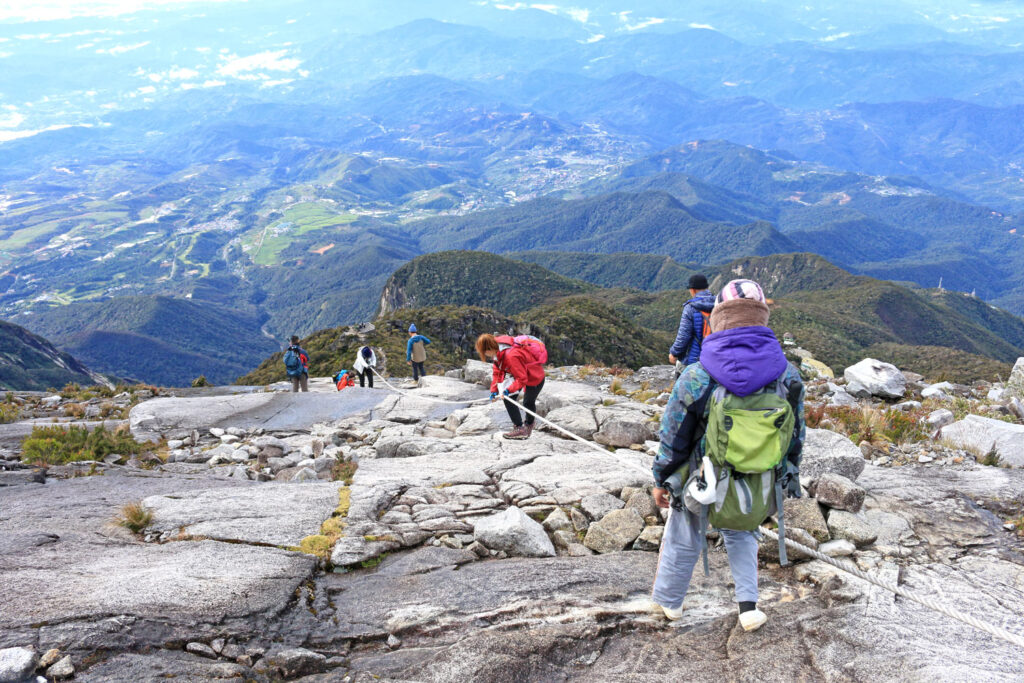
4. Track Conditions
There is one word that best describes the track that leads to the summit of Mount Kinabalu – STEEP.
Most of the track is made up of steps, steep ones. So, you are constantly lifting your legs high up to climb these steps. And when you’re descending, you have to step down a long way which puts a lot of strain on your knees and lower legs (think calves).
The track changes from Laban Rata onwards all the way to the summit. It gets steeper, and the steps disappear only to be replaced by smooth, slick rock. This can get slippery after the rains. In some places, it’s so steep that there is a rope in place to help you pull yourself up those steep rocks.
Aside from the steep nature of the trail, the track is actually well made and maintained. There are handrails most of the way to Laban Rata so you can hold on to them, especially when descending (and if you don’t have any trekking poles).
The track is quite narrow in places and given your speed you might need to pass lots of slow hikers up the stairs. This can get tricky sometimes and you end up getting stuck behind a group of slow hikers.
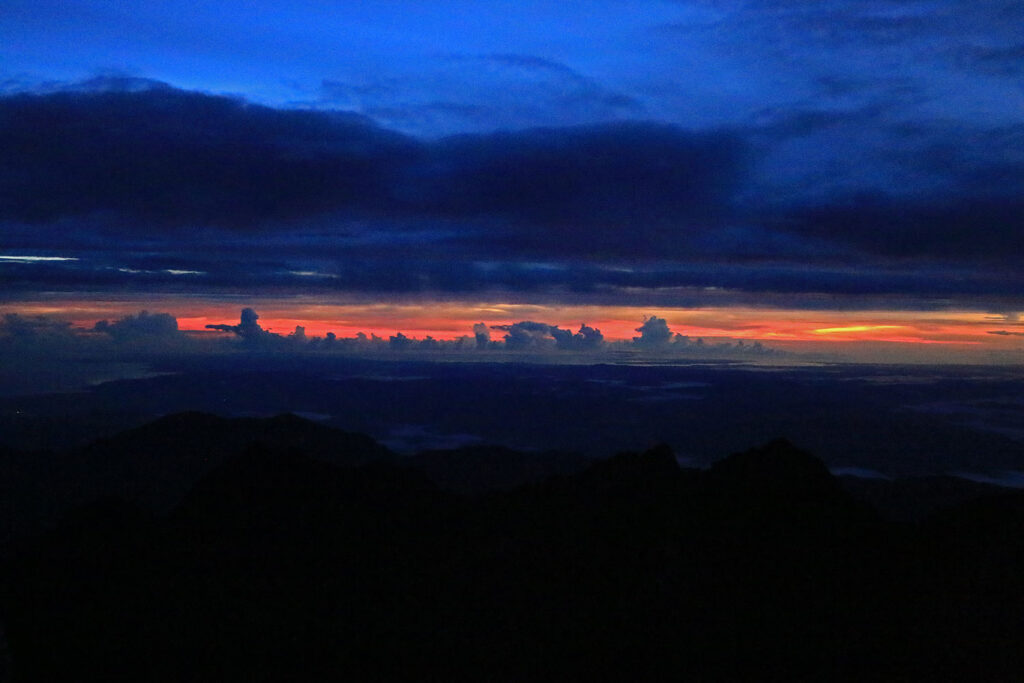
5. Weather Conditions
With any mountain climb, the weather can be unpredictable. Even if you time your climb to coincide with the best weather window (February to April, August and September), you can’t be guaranteed to get perfect weather all the time. It’s really the luck of the draw as to whether you get good weather on your climb or not.
In general, it rains most days on Mount Kinabalu so you’re almost guaranteed to get some rain at some point during your climb. Having it rain on you as you climb is not such a bad thing as it can get a bit hot and sweaty climbing the mountain.
There are times of the year when you should not be climbing Mount Kinabalu as the weather can get terrible. During the monsoon or rainy seasons (May to July and October to January), there can be gale force winds and cyclonic weather, especially at the higher elevations of the mountain.
“do not climb mount kinabalu during the wet season.”
My Experience
I’ve been lucky on both occasions to get good weather (mostly). However, when I say good weather, it rained both times on Day 1 and it rained on Day 2 as well when I climbed Mount Kinabalu for the second time.
I’ve climbed in February and in April, both months being good times to climb Mount Kinabalu.
On both occasions, the weather has been perfect (no rain) for the climb to the summit which is the most important part of the climb. The views from the summit have also been spectacular with less clouds in April than in February.
I’ve had friends climb Mount Kinabalu who have experienced the worst weather with cyclonic rain and windstorms. They, and all the other climbers, had to evacuate the mountain after reaching Laban Rata without making it to the summit. What a shame!
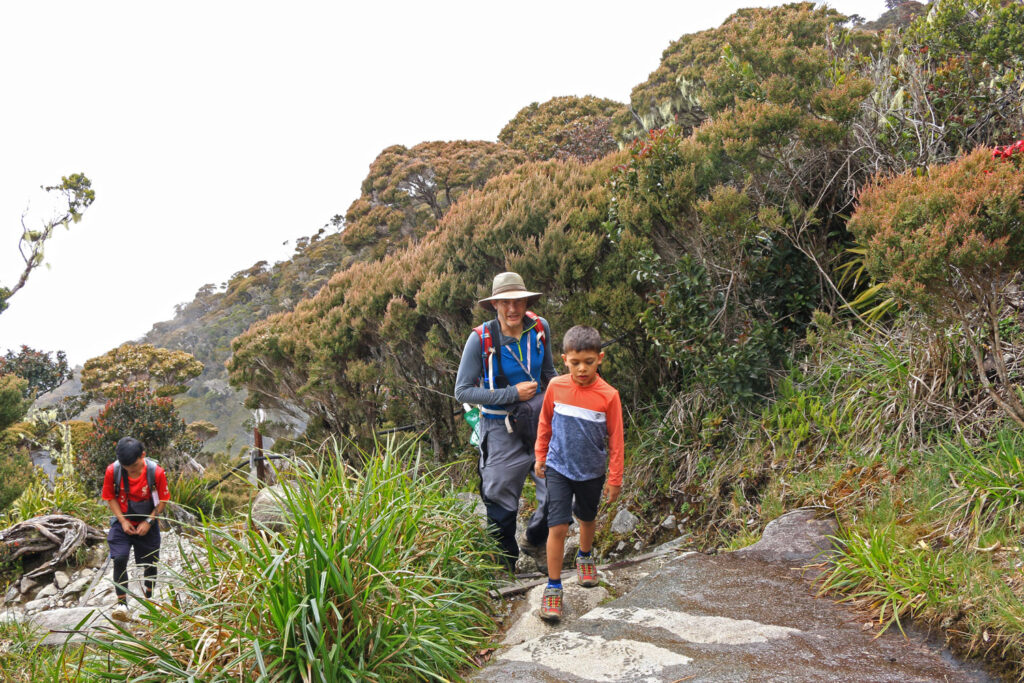
6. Physical Fitness Levels
Physical fitness levels vary from person to person and everyone is different. In general, the longer you’ve been climbing mountains, the better your fitness level will be for climbing Mount Kinabalu.
It also depends how often you climb at altitude. Getting your body acclimatized to being at altitudes above 3,500 meters (11,483 feet) makes it easier to climb Mount Kinabalu. Of course, this is not possible for most people as there aren’t a lot of mountains or areas above 3,500 meters in or near the city.
My Experience
I found that my physical fitness level was a lot higher the second time I climbed Mount Kinabalu even though I was 14 years older. This was because I had no experience climbing mountains the first time I climbed Mount Kinabalu. However, on the second occasion, I had been climbing mountains regularly for over two years. My muscles were adapted to climbing, my body was accustomed to being over 3,500 meters (11,483 feet) and my energy could last the distance without running out.
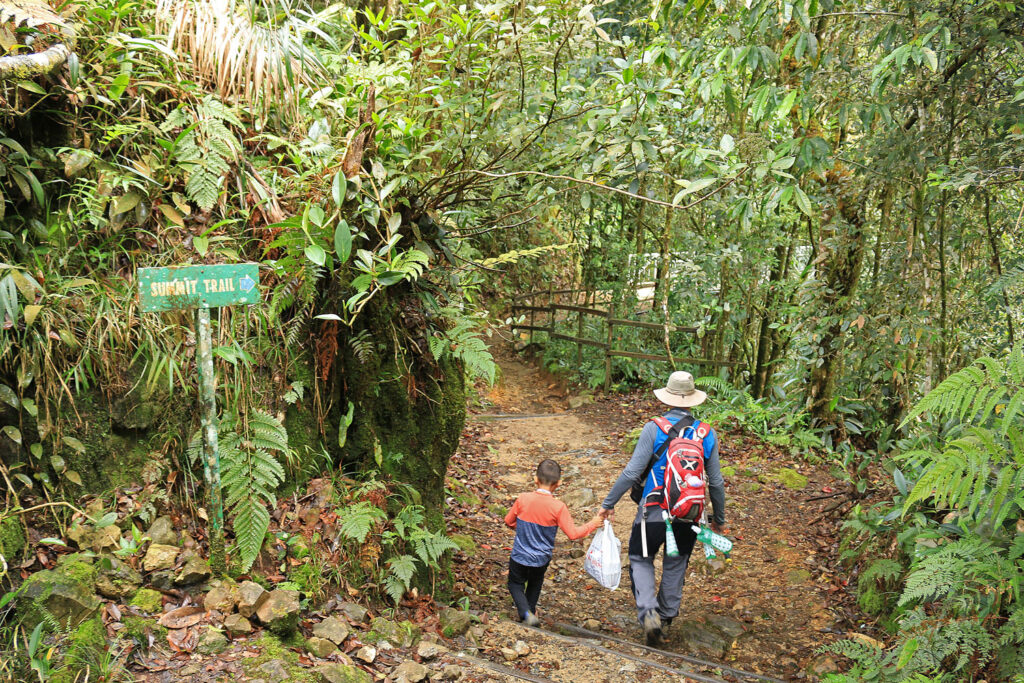
7. Temperature and Humidity
Mount Kinabalu sits in the tropical belt of Sabah, Malaysia where the weather is hot and humid for most of the year. Here, the temperature ranges from 25 to 30 degrees throughout the year, while the humidity ranges between 85 to 90%. It’s the humidity that actually makes it feel hotter than it really is. The rain can also make the air more humid and hence more steamy.
I live in tropical north Queensland, Australia where the weather is similar to Sabah (hot and humid). I can clearly say that it’s a lot harder climbing mountains in summer than in winter. The body has to work twice as hard when it is hot in order to provide oxygen/blood to the muscles as well as to the skin to cool down.
When climbing Mount Kinabalu, expect to sweat a lot, especially on Day 1.
However, when you reach Laban Rata guesthouse and stop trekking, you will start to feel the cold. There is no heating in the guesthouses on the mountain, so you will need to have a jacket or thermals to keep warm. From Laban Rata to the summit, it will be cold but not too extreme.
Once the sun comes out on Day 2, it will start to get warm again. By the time you reach Laban Rata guesthouse after climbing to the summit, it will be quite hot again. The climb back down the mountain from Laban Rata will be hot and sweaty, although not as much as the climb up.

8. Clothing and Gear
Last but not the least is the clothes and gear you take with you that will determine how your Mount Kinabalu climb goes. Having the right set of clothes and hiking gear is paramount to having a successful and enjoyable climb.
Keeping in mind the weather and humidity, the items you will need for an overnight stay as well as the weight of your backpack is important.
When climbing Mount Kinabalu, you need to ensure you pack light but have the essential items with you. Items such as a breathable raincoat that can also be used as a winter jacket to protect against wind and cold is important. Most people use trekking poles and you need to decide whether you want to use these or not.
In all my experience climbing mountains, I have learnt the golden rule of mountain climbing – pack light. Packing light is essential as any heavy load makes the climb harder as you have to carry that weight with you up the mountain. It’s not as taxing on a flat surface, but when you’re climbing a steep mountain like Mount Kinabalu you will really start to feel the weight by the end of the climb.
My Experience
The second time I climbed Mount Kinabalu I decided not to use trekking poles since I wasn’t carrying a heavy backpack. However, this was a big mistake especially for the descent which was particularly hard on my knees. Every other climber had trekking poles and I wish I did too. That was a hard lesson to learn.
“Multiple elements combined make the Mount kinabalu climb difficult.”
So there you have it – all the elements that make climbing Mount Kinabalu difficult. There is not one or two but a combination of all these elements that make the climb difficult. A little bit of luck is also required when it comes to the weather. However, with the right training, planning and mindset, climbing Mount Kinabalu doesn’t have to be as difficult as it should be.
Have you climbed Mount Kinabalu before or are you planning a Mount Kinabalu climb soon? Let me know what you think about the Mount Kinabalu climb difficulty. How hard is Mount Kinabalu to climb?
I love to hear from my readers, so please leave your comments below.


